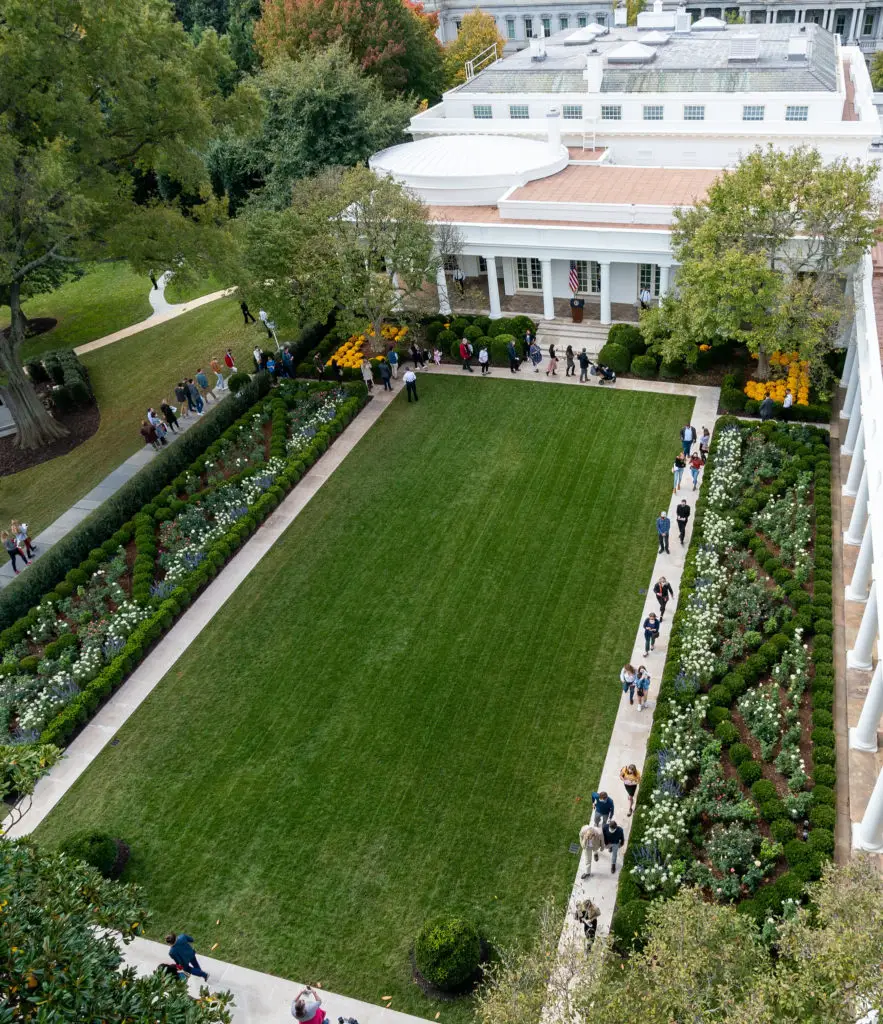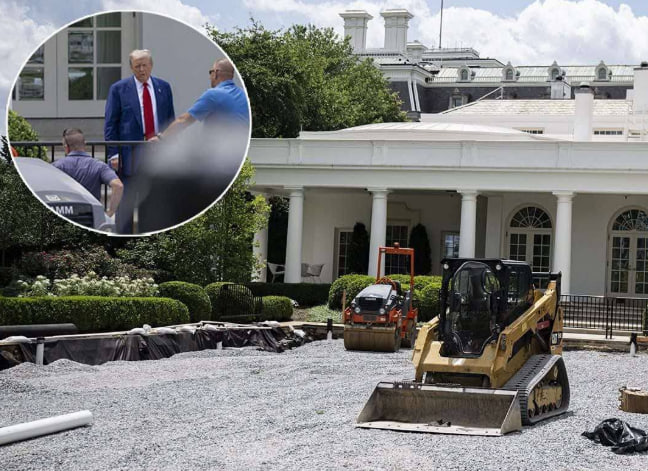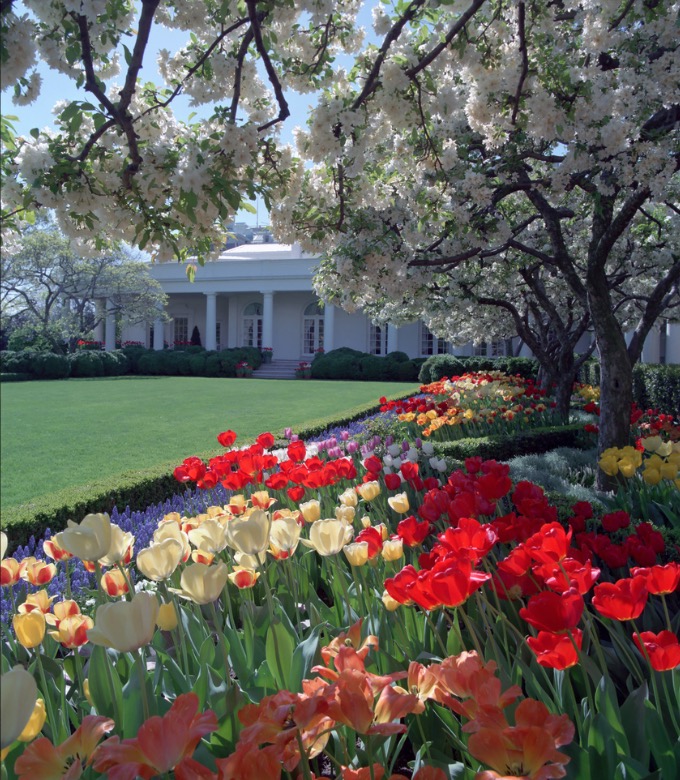The White House Rose Garden is one of America’s most iconic and carefully planned outdoor spaces, serving for decades as the backdrop to historic speeches, state events, and press conferences. Recent renovations during the Trump administration have drawn significant public interest and debate. This article provides a clear, fact-based look at those renovations, their purpose, design elements, and historical context.

Historical Background of the Rose Garden
The modern Rose Garden was designed in 1962 under President John F. Kennedy’s administration. First Lady Jacqueline Kennedy asked landscape designer Rachel Lambert Mellon to reimagine the space just outside the Oval Office. Mellon’s plan was widely praised for its simple elegance and classical layout, with symmetrical flower beds featuring roses and seasonal flowers, bordered by boxwood hedges, and framed by a central lawn for ceremonies.
According to the White House Historical Association, the Rose Garden was intended to combine formal European-style design with plants suited to Washington, D.C.’s climate. Over the years, it became the site of major presidential events, diplomatic receptions, and press briefings (source: White House Historical Association).
Renovations Under the Trump Administration
Timeline and Scope
The most recent renovations began in 2020 during the presidency of Donald J. Trump, led by First Lady Melania Trump. According to the White House at the time, the project aimed to address structural issues, improve drainage, and restore elements of Mellon’s original design that had changed over time.
The official White House announcement described the goals as follows:
-
Infrastructure upgrades: including a new drainage system and electrical improvements to support broadcast events.
-
Accessibility improvements: ensuring ADA-compliant pathways for people with disabilities.
-
Horticultural restoration: reintroducing plantings consistent with Mellon’s design while ensuring disease-resistant rose varieties (source: White House Archives).
Key Features of the 2020 Redesign
-
Replacement of turf and installation of new drainage to prevent water pooling.
-
Limestone walkways added to improve accessibility and maintain symmetry.
-
Boxwood hedges retained along the borders, consistent with the Mellon plan.
-
Introduction of white and pastel roses, in keeping with historic design cues.
The project was funded through private donations, as confirmed by the White House. Melania Trump noted in an official statement that these updates were intended to preserve the garden for future generations while accommodating the technical needs of modern presidential events.
Continued Work in 2024
In 2024, under President Trump’s second term, reports have indicated further landscaping work around the Rose Garden. News photos (including images from government photographers) show construction equipment near the site and some areas cleared for additional work.
According to the Associated Press, plans discussed during this period included new flagpoles on the North and South Lawns, and the addition of a ballroom within the White House grounds. While specific timelines and budgets for these broader projects were not fully disclosed, Trump publicly described the flagpoles as intended to enhance the symbolism of the White House grounds (source: Associated Press).
Photos of the Rose Garden from mid-2024 (e.g., Trump White House Archives on Flickr) show the central lawn area under construction, with visible gravel and equipment. Official sources characterized this phase as part of continued restoration and maintenance rather than a wholesale redesign.
Public Reaction and Commentary
Presidential renovations of the White House grounds often draw strong public attention, and these changes were no exception. Some commentators and historians expressed concern that any alterations might undermine Rachel Mellon’s historic design.
For example:
-
Architectural historians have emphasized the importance of maintaining Mellon’s symmetry and horticultural palette.
-
Critics noted that replacing the central lawn with gravel, even temporarily for construction, appeared starkly different from its traditional appearance.
That said, the White House position, both in 2020 and in later updates, has consistently described the renovations as restoration projects designed to ensure longevity, accessibility, and functionality for presidential events.
Addressing Misconceptions
It is important to clarify:
-
The renovations did not eliminate the Rose Garden but reworked pathways, drainage, and planting beds to sustain the space.
-
The iconic boxwood borders remained intact through these phases of renovation.
-
Plantings changed to newer rose cultivars selected for disease resistance while aiming to maintain Mellon’s intended aesthetic.
Such upgrades are typical for historic gardens requiring regular maintenance to address evolving horticultural and infrastructure needs.
Preservation and Future Use
White House gardens have evolved over centuries to balance tradition and practical use. According to the National Park Service, which oversees the White House grounds as a National Historic Landmark, landscape maintenance is a continuous process that seeks to honor historical plans while supporting current needs.
Presidents routinely use the Rose Garden for:
-
Official announcements
-
Press conferences
-
Diplomatic events
Maintaining the garden’s structure and functionality is essential for these uses, which explains the emphasis on accessible walkways and durable turf capable of handling foot traffic and broadcast setups.
Conclusion: Tradition Meets Modernization
The White House Rose Garden remains one of the most recognizable and historically significant features of the Executive Residence. While renovations under the Trump administration sparked debate, official records and architectural plans consistently described the efforts as restorations rather than redesigns. The focus was on repairing infrastructure, improving accessibility, and restoring elements of Rachel Mellon’s iconic vision.
By understanding the historical context and the documented scope of these renovations, the public can better appreciate the balancing act required to preserve national heritage while supporting the demands of a modern presidency.
References
-
White House Historical Association – Rose Garden History
-
Trump White House Archives – Rose Garden Renovation Announcement
-
Associated Press – White House Plans for Flagpoles, Ballroom
-
National Park Service – White House Grounds



